Gottstein G., Shvindlerman L.S. Grain Boundary Migration in Metals: Thermodynamics, Kinetics, Applications
Подождите немного. Документ загружается.

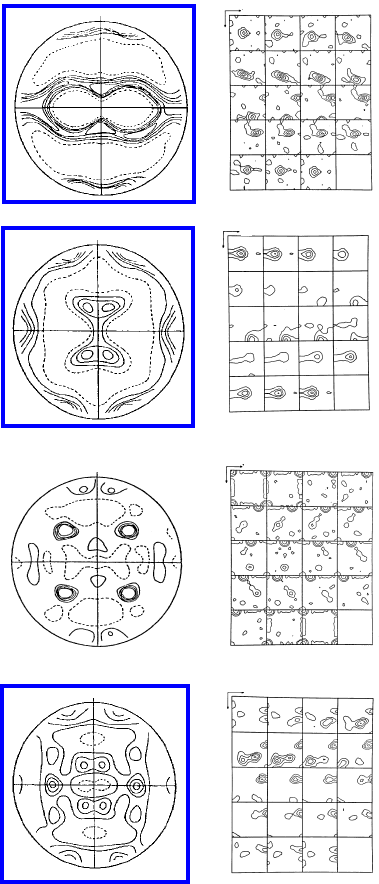
546 6 Applications
RD
RD
RD
RD
(a)
(b)
(c)
(d)
φ
ϕ
1
φ
ϕ
1
φ
ϕ
1
φ
ϕ
1
FIGURE 6.27
Rolling and recrystallization textures of Cube metals in {111} pole figure and
Euler space. (a) Cu-type rolling texture; (b) brass-type rolling texture; (c)
Cube texture (Cu-recrystallization texture); (d) brass recrystallization tex-
ture.
© 2010 by Taylor and Francis Group, LLC
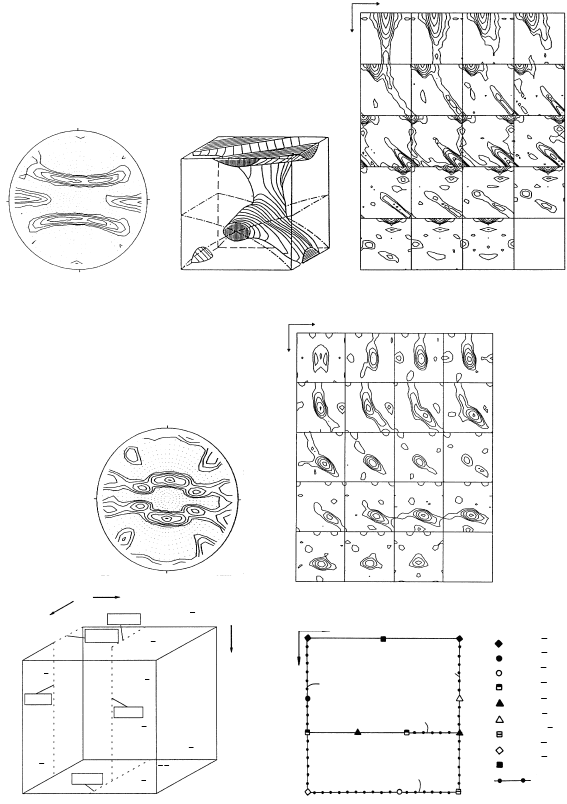
6.2 Recrystallization annd Grain Growth 547
Φ
ϕ
2
ϕ
1
{110} R D
levels: 0.5
1
2
4
MAX = 6.3
ϕ
2
= const.
ϕ
2
Φ
FUNE ODF
MAX = 35.6
levels:
2 4 7 12
20 30
MAX = 35.6
levels:
2 4 7 12
20
ϕ
2
ϕ
1
= const.
ϕ
2
FUNE ODF
Φ
{110} R D Levels: 0.5
1
2
4
7
10
MAX = 10.3
ϕ
2
Φ
η
fibre
ϕ
1
(a)
(b)
(c)
γ
fibre
ε
fibre
ξ
fibre
(011)[100]
(001)[100] α
fibre
(110)[001]
(001)[
110
]
(111)[
110
]
(001)[
110
]
(111)[
121
]
(111)[
112
]
(111)[
011
]
(112)[
111
]
(011)[
211
]
(011)[
011
]
(001)[
(112)[
(110)[
(111)[
(111)[
(112)[
(110)[
(110)[
(001)[
110
]
110
]
]
]
]
112
111
110
00 1
112
]
]
]
110
010
]
fibre
<001> II ND
ϕ
1
α
Φ
ϕ
2
= 45°
ξ
γ
ε
<111> II ND
<110> II RD
<110> II TD
FIGURE 6.28
Rolling and recrystallization texture of bcc metals (ferritic steel). (a) {110}
pole figure, and ODF in 3D and sectional Euler space of rolling texture; (b)
{110} pole figure and ODF in Euler space; (c) location of fibers in Euler space
that contain the main texture components. The ϕ
2
=45
◦
sections contain the
most information.
© 2010 by Taylor and Francis Group, LLC
548 6 Applications
6.2.4.2 Pure Metals: Growth Selection
In such experiments a single crystal is slightly deformed, for instance by
rolling. If the orientation of the single crystal does not change or decompose
during deformation, the deformed specimen still represents a single crystal
but with a stored energy of cold work in terms of the elastic energy of the
stored dislocations. After deformation, one face of the single crystal will be
subjected to an additional strong deformation, e.g. by grinding, filing or saw-
ing. Afterwards the sample is annealed in a strong temperature gradient, such
that only a small volume of the sample is heated while the remaining deformed
volume is kept at ambient temperature (Fig. 6.29). Annealing starts at the
additionally deformed end, giving rise to a high nucleation density with vir-
tually random orientation distribution. These nuclei grow upon displacement
of the hot zone and compete with one another such that the fastest growing
grains will cut off the path of the more slowly growing grains, and eventually
a single grain will dominate and cover the entire cross section of the consumed
single crystal. Obviously, this final surviving grain will be the fastest (max-
imum growth rate orientation), and the grain boundary between this grain
and the deformed single crystal possesses the highest mobility among all com-
peting grain boundaries. Of course, a single experiment might give incidental
results. However, hundreds of experiments were conducted on high purity Al
with the overwhelming result that grains with a 40
◦
111 orientation rela-
tionship to the deformed matrix evidently grew fastest. Naturally, there is a
certain statistical distribution of fast-growing orientations. However, the fur-
ther the competing grains proceed into the consumed deformed single crystal,
the sharper the distribution of misorientation angles (Fig. 6.29).
According to such experiments, the maximum of the distribution is attained
at an angle slightly above 40
◦
about a 111 axis. In the past, the high mobil-
ity of 40
◦
111 boundaries was interpreted such that the 40
◦
111 boundary
actually represented a 38.2
◦
111 Σ7 coincidence boundary [394, 587]. Owing
to the high density of coincidence sites the boundary would segregate less so-
lute atoms than other boundaries and thus be less affected by impurity drag.
Less impurity drag is equivalent to a higher effective driving force and thus
higher growth rate. In fact, the orientation dependence of grain boundary mo-
bility measured for the individual grain boundaries proved that low Σ CSL
boundaries (special boundaries) behaved in a more mobile way than random
boundaries (non-special boundaries), and among all boundaries with low in-
dex rotation axes the Σ7 boundary moved fastest (see Chapter 3). However,
the maximum growth rate misorientation is distinctly different from the Σ7
orientation relationship, and always larger by at least 2 degrees. Thus, the
interpretation given above obviously is at variance with the results of growth
selection experiments. A more detailed analysis reveals the reason for the dis-
crepancy. The Σ7 boundary indeed moves fastest at temperatures below 430
◦
C
(Fig. 6.30) while at higher temperatures the 40.5
◦
111 boundary exhibits the
highest mobility. Given the fact that the temperature during growth selection
© 2010 by Taylor and Francis Group, LLC
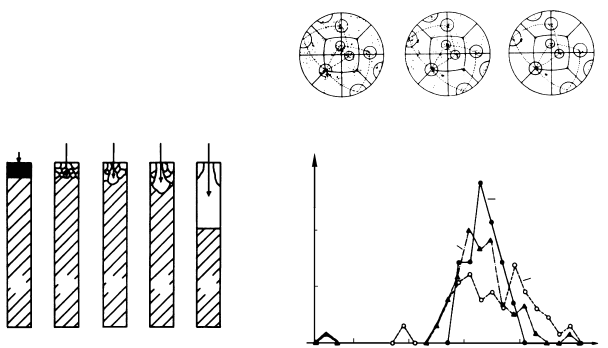
6.2 Recrystallization annd Grain Growth 549
cut
region
NNN N
M
MM
M
M
10
stage I
5
stage II stage III
stage I
stage II
stage III
140° 150° 160° 170°
rotation angle
(a) (b)
f
FIGURE 6.29
(a) Principle of growth selection; (b) {111} pole figures and frequency distri-
bution of the orientations still in contact with the deformed matrix for three
consecutive stages of growth selection ([586]).
experiments is very high, typically above 600
◦
C for Al, it is evident that such
experiments are designed to reveal a 40
◦
111 misorientation as maximum
growth rate (mis)orientation rather than the Σ7 misorientation (Fig. 6.31).
The physical principle that creates this confusion is the compensation ef-
fect discussed at length in Chapter 3. At temperatures below the compen-
sation temperature T
c
the process with the lower activation enthalpy will
dominate, while above T
c
such mechanisms are favored that carry the largest
pre-exponential factor (Fig. 6.32). It is noted that this result reveals a com-
mon misconception, namely that the process with the lower activation en-
thalpy will always be favored, tacitly assuming that the pre-exponential factor
hardly varies, which is obviously wrong. The widely practiced habit to ana-
lyze thermally activated processes only with regard to the activation enthalpy
is, therefore, liable to serious misinterpretation. This is particularly true for
interfacial phenomena, where the activation enthalpy varies in a wide range.
For instance, if only the activation enthalpy would differ for the mobility of
dissimilar (large angle) boundaries, the mobilities would differ by many or-
ders of magnitude, while in reality the mobility of grain boundaries varies only
within a factor of ten or so.
© 2010 by Taylor and Francis Group, LLC
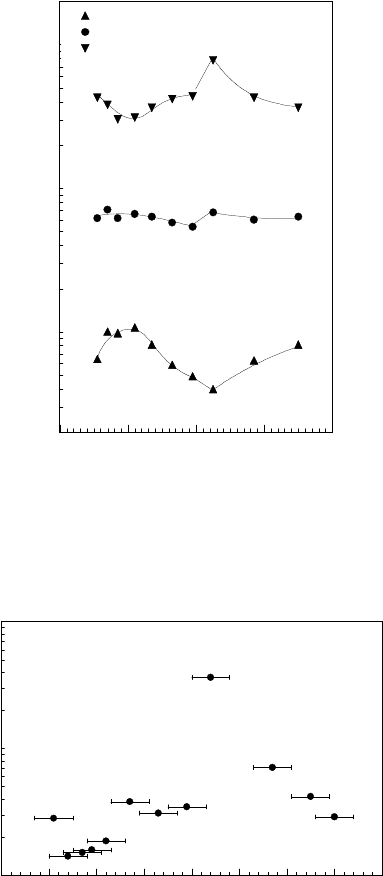
550 6 Applications
430°C
485°C
540°C
10
-7
10
-8
10
-9
A [m
2
/s]
36 38 40 42 44
ϕ
[deg]
430°C
485°C
540°C
FIGURE 6.30
Dependence of the reduced mobility of 111 tilt grain boundaries on rotation
angle in pure Al at different temperatures.
T=615°C
T = 615°C
T = 615°C
10
8
10
7
10
6
A [
μ
m
2
/s]
36° 37° 38° 39° 40° 41° 42° 43° 44°
misorientation
ϕ
FIGURE 6.31
Reduced mobility of investigated 111 tilt grain boundaries in Al at 615
◦
C
(obtained by extrapolation of the measured temperature dependence to
615
◦
C).
© 2010 by Taylor and Francis Group, LLC
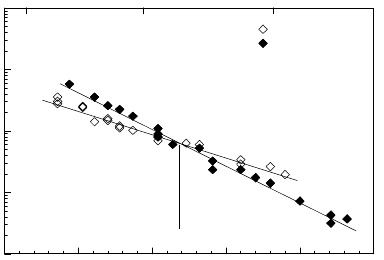
6.2 Recrystallization annd Grain Growth 551
38.2°<111>
40.5°<111>
T
c
550 500 450
T [°C]
10
-6
10
-7
10
-8
10
-9
10
-10
1.2
A [m
2
/s]
1.25 1.3
1.35
1.4 1.45
40.5° <111>
38.2° <111>
T
c
1/T [10
3
/K]
FIGURE 6.32
Temperature dependence of the reduced mobility A for 38.2
◦
and 40.5
◦
111
tilt grain boundaries in pure Al.
6.2.4.3 Growth-Controlled Recrystallization Textures
Growth selection experiments on pure aluminum have clearly established the
high growth rate of 40
◦
111 tilt boundaries in this material. Its importance
for microstructure development, however, derives from the fact that the main
components of the recrystallization textures of rolled Al (Cube texture) can be
related to the major rolling texture components (S-orientation) by a 40
◦
111
orientation relationship (Fig. 6.33). This constitutes the basis of the so-called
“theory of oriented growth” which contends that the recrystallization texture
forms from (tacitly assumed) randomly oriented nuclei by growth selection in
favor of maximum growth rate orientations, i.e. 40
◦
111. There have been
refinements to this approach to account for obvious discrepancies from ideal
40
◦
111 rotations, in particular the compromise texture approach, which de-
mands that a growing grain be able to grow quickly into more than a single
component of the rolling texture (Fig. 6.33) [583]. More refined modeling ap-
proaches [588] and computer simulations [589] have confirmed that a growth
preference of a 40
◦
111 rotation leads to the observed recrystallization tex-
tures. The influence of a growth advantage is so strong that other compromise
40
◦
111 rotations are completely suppressed even if their compromise fit is
marginally less perfect. This would explain why other potential recrystalliza-
tion texture components were never observed.
Other approaches also have been put forward recently to explain the dom-
inance of the 40
◦
111 misorientation, even in the absence of an orientation-
dependent growth rate. Besides the classical contention of oriented nucleation,
© 2010 by Taylor and Francis Group, LLC
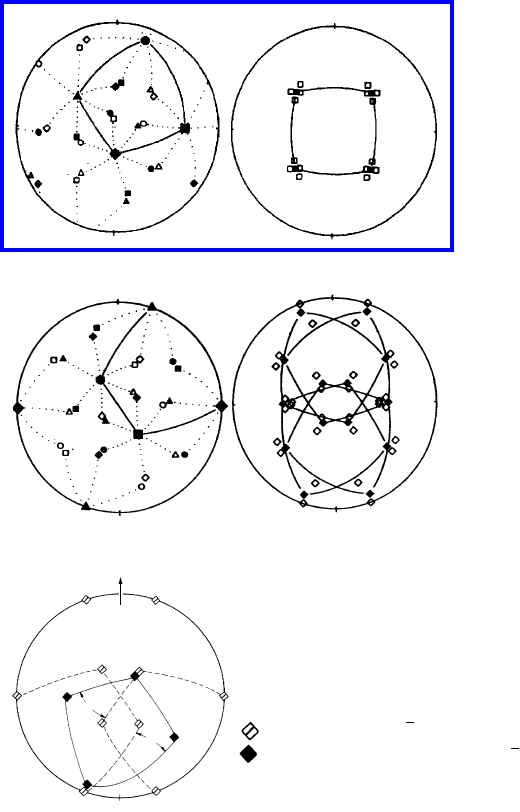
552 6 Applications
R D
R D
S (left) and Cube (right) with 40° <111> rotations of S
R D
R D
= Bs-texture
{}011 21 1
<>
= Bs-recrystallization texture
{236}
<>
385
RD
~40°
~40°
{111}
Bs (left) and Bs/R (right) with 40° <111> rotations of Bs
(a)
(b)
(c)
FIGURE 6.33
Orientation relationship between rolling and recrystallization texture compo-
nents. (a) The Cube texture satisfies a best fit of a 40
◦
111 rotation of the
S orientation; (b) the brass recrystallization texture is related to the brass
rolling texture by a 40
◦
111 rotation; (c) illustration of the orientation rela-
tionship for one brass rolling and recrystallization component.
© 2010 by Taylor and Francis Group, LLC
6.2 Recrystallization annd Grain Growth 553
i.e. the preferential nucleation of major recrystallization texture components,
e.g. the Cube texture in aluminum, an effect of orientation pinning recently
was proposed [590]. Orientation pinning relates to the experimental obser-
vation that small angle boundaries (and coherent twin boundaries) have low
mobility and can be considered as essentially sessile. While it is difficult to
completely block a grain boundary in three dimensions this concept also can-
not satisfactorily account for the observed recrystallization textures [591], al-
though it amplifies selective growth and thus perhaps another reason for the
observed sharp recrystallization textures in aluminum alloys.
A truly surprising phenomenon is that the selective growth, which was
unambiguously evidenced in pure Al, can also account for recrystallization
texture formation in other metals and alloys, even intermetallic compounds.
For instance, the recrystallization texture of Cu-30%Zn (α−brass) can be
successfully predicted by assuming a compromise texture of 40
◦
111 rota-
tions (Fig. 6.33) [592]]. This is remarkable, since the deformation structure
and the recrystallized microstructure of brass are entirely different from the
deformed and recrystallized state of Al, namely heavily twinned and shear
banded after rolling as well as fine-grain sized and massively twinned after
recrystallization. The major problem of relating the recrystallization texture
to the rolling texture in brass is the fact that not all theoretically predicted
compromise orientations appear in the experimental recrystallization texture.
This problem can be mitigated by twin formation as an additional selective
nucleation process [593].
Forcopperandsilvera30
◦
111 rotation seems to more appropriately de-
scribe the maximum growth rate orientation, as evident from recrystallization
experiments on single crystals. Growth selection experiments are more difficult
to conduct for these materials, since repeated annealing twin formation gen-
erates high-order twin families, which interfere with the growth process such
that usually more than a single grain survives growth competition [594]. Nev-
ertheless, the grains surviving growth selection can be associated with some
scatter to a 30
◦
111 orientation relationship between growing grain and con-
sumed deformed matrix. To reconcile the results on Al with observations on
other fcc materials, reference usually is made to a 30
◦
− 40
◦
111 rotation.
This is, however, incorrect, as shown by very detailed investigations on Al and
can only be tolerated in view of the lack of reliable data on materials other
than Al.
The dominance of 40
◦
111 rotations is truly remarkable. If an Al single
crystal is deformed such that the spread of the orientation will slightly favor
the occurrence of only a single variant of all possible eight ±40
◦
111rotations,
then the recrystallization texture consists of only one component (Fig. 6.34),
namely this variant, despite the fact that there are many other orientations
present in the orientation spread of the deformed matrix [595, 596]. Even more
surprising is the recrystallization texture of deformed single crystals with a
stable orientation during rolling. The recrystallization texture comprises ex-
actly all eight ±40
◦
111 rotations of the rolled single crystal orientation,
© 2010 by Taylor and Francis Group, LLC

554 6 Applications
TTT
RD
RD
deformation texture orientation relationshipsrecrystallization texture
SA SA SA
CD CD CD
RD
(a)
(b)
FIGURE 6.34
{111} pole figures of deformed and recrystallized Al single crystals (according
to [596]). (a) 112 crystals, tensile deformed 50%; (b) (2.1.10)[42
¯
1] crystal,
80% rolled.
irrespective of whether it is aluminum, brass [593] or even the intermetallic
compound Ni
3
Al (Fig. 6.35) [597]. The latter case is particularly surprising,
since rolled Ni
3
Al polycrystals exhibit only a very weak recrystallization tex-
ture, and it is generally assumed that long-range order strongly reduces grain
boundary mobility and thus eliminates a particular orientation dependence of
grain boundary mobility.
Recently, Hutchinson [598] proposed attributing the observed frequency of
40
◦
111 rotations to a special property of a random misorientation distri-
bution. When a random misorientation distribution is sorted into rotations
about low index rotation axes, e.g. 111 rotation axes, allowing for a devi-
ation of about 15
◦
, the corresponding angular misorientation distribution is
not random but peaks at an angle of about 30
◦
, similar to growth selection
experiments; however, this result has to be treated with caution. In growth
selection experiments it is determined which orientation grows into a specific
(single crystal) orientation. If this growth would be orientation independent
then the distribution of successful grains ought to represent the orientation
distribution itself and not the misorientation distribution. Besides, the com-
puted angular misorientation distribution is distinctly different from growth
selection results on Al, and the results of mobility measurements on individ-
ual grain boundaries in Al prove an orientation dependence of grain boundary
© 2010 by Taylor and Francis Group, LLC
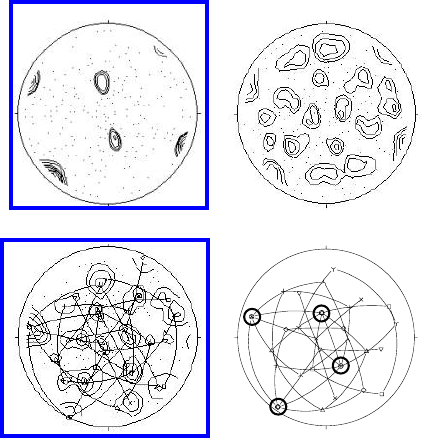
6.2 Recrystallization annd Grain Growth 555
RD
M
111
lq
(a)
R D LEVELS:
30
1
20
15
7
4
2
KO801
MAX= 35.1
10
111
lq
R D
LEVELS:
1
2
4
7
MAX= 8.6KO803
R D
R D
111
lq
LEVELS: 1
2
4
7
MAX= 8.4SO8010
(b)
FIGURE 6.35
(a) {111} pole figure of rolling and recrystallization texture of a (617)3.10.
¯
4
single crystal of Ni
3
Al; (b) the recrystallization texture comprises all eight
±35
◦
111 rotations of the single crystal orientation.
© 2010 by Taylor and Francis Group, LLC
